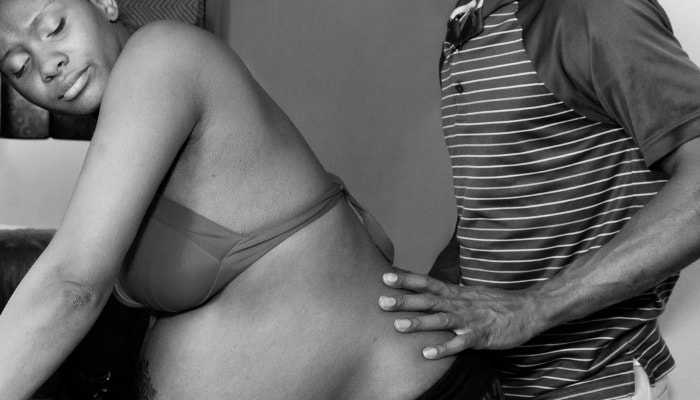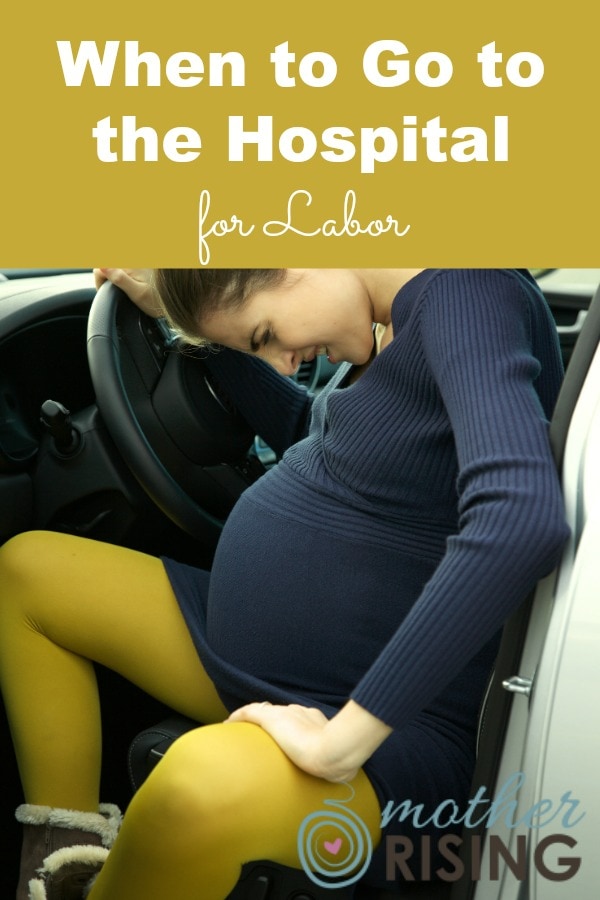Whether you’re a first time mom, a seasoned pro, planning for a VBAC, or pregnant with twins, it’s important to know when to go to the hospital for labor. Many women use the rule of thumb 5-1-1, and others use 4-1-1, while others go on different information entirely. Which is right for you?
In this blog post we’ll discuss the ins and outs of knowing when to go to the hospital for labor so that you’ll make it with plenty of time (and not have a car baby). Let’s get started!
Understanding Labor
Part of knowing when to go to the hospital for labor requires knowing a little bit about the body and also how labor progresses.
Signs of Labor
If you are experiencing the following signs of labor it just might mean that it’s time for baby!
- Dropping
- Nesting and Restlessness
- Irritability
- Back Ache
- Diarrhea
- A Spidey Sense
- Dilation
- Effacement
- Cervical Movement
- Bloody Show or Mucus Plug
- Contractions that become stronger, longer and closer together
- Water Breaking
But at what point should a woman head to the hospital for birth?
First Stage of Labor
A woman should go to the hospital when she is in the first stage of labor but before she reaches the second – the pushing stage. Stage one of labor, however, is the longest stage and the most varied. Thankfully, this stage can be broken into three distinct phases. Knowing each of these phases makes it simpler to know when to stay home and when to go in.
Early Labor
Unless there is a medical indication for being at the hospital, like an induction, women should not arrive at the hospital during early labor.
Early labor is when contractions are further apart, around 5-7 minutes apart. Contractions are shorter, around 30 seconds long, and are generally easy to cope through. For example, women are generally able to walk and talk through contractions and continue on with some normal activities. If a woman arrives at the hospital in early labor, due to the sensitive nature of the hormones of birth, there’s a chance things may fizzle out and she will be sent home.
For more information and to learn coping strategies for early labor, head on over here.
Active Labor
Most women plan to arrive at the hospital during active labor.
Active labor is when contractions become closer together, around 3-5 minutes apart. Contractions are stronger, longer (around 60 seconds long), and closer together. In early labor, women were able to walk and talk through contractions. However, in active labor women have to actively cope through each contraction by using breathing techniques, a birthing ball, changing positions, etc.
For more information about active labor and how best to cope through it, head on over here.
Transition
Most women hope to avoid arriving to the hospital during transition, but for others this is their goal. Some women hope to labor at home as long as possible before heading in! These women are likely hoping to get through labor without pain medication or an epidural.
Transition, the shortest but most difficult portion of active labor, is when contractions are longer (90 seconds long), stronger, and closer together at around 2-3 minutes apart. Women may feel nauseous and throw up during transition, feel shaky, hot and then cold, and say things like “I can’t do this anymore”. She may be slower moving, and less responsive to questions and comments – even between contractions.
Support from the birth team is crucial at this point, especially if a woman is hoping for a natural childbirth. Trying something new and words of encouragement from a doula or other support person make all the difference.
When to Go to the Hospital for Labor
But what about you? How do you know when to go to the hospital for labor? How will you know what decision is right for you?
Of course, always consult with your care provider as they know you and your baby more than a website ever could. The following are things to think about when deciding when to go to the hospital for labor.

Birth Plan
Other than having a healthy mom and baby, what are your goals for labor? What’s on your birth plan? Are you hoping on having an unmedicated birth? Do you want an epidural as soon as possible? The answers to these questions will impact your decision on when to head on in.
Many women that are hoping to have an unmedicated birth, under the direction of their care providers, labor at home as long as possible. Women in these scenarios often experience a shorter, less painful labor because of being in the comfort of their own home, but also because birth is allowed to unfold without much interruption.
But some women choose to give birth with an epidural and desire that option as soon as possible. These women may choose to head in as soon as she’s in active labor and contractions are around 5 minutes apart.

How Far Apart Should Your Contractions Be before Going to the Hospital?
So, how far apart should your contractions be before going to the hospital?
5-1-1
From what I’ve seen, the general consensus is to go to the hospital when contractions are at 5-1-1, which is when contractions are 5 minutes apart, each contraction is lasting for 1 minute and this has been going on for 1 hour. This is especially true for those who live further away from the hospital, have heavy traffic to contend with, whose care provider would like you there at that point, and/or need antibiotics due to being group strep positive.
4-1-1
However, for all others, and especially first time moms, I think a more realistic approach is to go to the hospital when contractions are at 4-1-1, which is when contractions are 4 minutes apart, each contraction is lasting for 1 minute and this has been going on for 1 hour.
I’ve found that there’s a big difference between the woman laboring with regular contractions five minutes apart and the woman with four minute apart contractions. Five minutes can still be in the land of early labor, whereas four minute apart contractions are definitely in active labor moving towards transition, which is what we want.
3-1-1
Some women and their care providers use 3-1-1 as their litmus test to help them decide when to go to the hospital for labor (which is not for every woman that’s for sure). 3-1-1 is when contractions are 3 minute apart, each contraction is lasting 1 minute or more and this has been going on for an hour or less.
When a woman arrives at the hospital with long, strong, and close together contractions that fit 3-1-1, she’s likely in transition and will be pushing soon. This may sound ideal to some women and a nightmare to others. 😉 Interestingly enough, arriving at the hospital “ready to push” is common advice for women planning for a VBAC. These women have had healthy pregnancies, are working closely with their care providers, and likely want minimal intervention at their births.

Water Breaking
When can a woman’s water break?
A woman’s water can break before labor begins, in the early, active, or transition parts of the first stage of labor, while she is pushing, and a baby can even be born in the amniotic sac. When your water breaks, call your care provider to see what they want you to do. Sometimes they are comfortable with you waiting for labor and laboring at home for awhile before coming coming in. Some care providers are not, and will want you to come in as soon as possible.
TIP: If you are reading this before labor has begun and during pregnancy, have a conversation about this topic with your care provider at your next prenatal appointment. I imagine that conversation will be very informative!
What Does It Feel like When Your Water Breaks?
All women are different, as are their pregnancies. Because of that, details vary about what it feels like when a woman’s water breaks.
Since a woman has rarely or never experienced this before, when her water breaks, it’s common for her brain to compare it to what she already knows. She knows what it feels like to pee. She also knows what it’s like when her period starts. As quickly as those thoughts come, right behind it is the new realization that this is something different. What she is feeling is her water breaking.
Back Labor
But what about back labor? If a woman is experiencing back labor, how will she know when to go to the hospital for labor?
For me, back labor felt like this —–>>> I began a contraction and felt my belly tighten as usual. Any sensation of cramping, pressure or pain would begin in my belly, but then slowly spread to my back. At that point, my focus shifted to my back as the back labor completely dwarfed any sensation in the front.
Back labor completely dominated my labor pain. If I was having pain in the front, I wasn’t really aware of it. All I could think about was the hot, burning pain in my back. As labor progressed, my contractions became stronger, longer, and closer together and my back labor became even more intense. In early labor, back labor was completely manageable. It felt like normal, annoying back pain. As things progressed to active labor and transition, that’s when I needed more help and ideas of to how to cope.
If a woman is experiencing back labor she may head to the hospital sooner rather than later for more support, rest, pain relief, and/or advice. On the other hand, many women experiencing back labor may proceed as normal and won’t adjust their plans. While they’re at home they may even discover ways to minimize or alleviate their back pain!

VBAC
Woman planning for a vaginal birth after a cesarean (VBAC) are under a closer watch due to the low risk of complications at birth. Because of that, they may be asked to come to the hospital in early labor, or when contractions are around five minutes apart. That way they can be closely monitored throughout the entirety of their birth experience.
Other women, however, may receive the advice to “show up ready to push”, which is transition. If only it were that easy to plan for and control! Whatever your plan may be, choose a quality care provider that makes decision based in reality and with evidence, not fear.
For more VBAC tips, head on over here!
Group B Strep
Group Beta Strep (GBS) is a normal bacteria found in the intestines and vagina. According to the CDC 10-30% of women are colonized with this normal bacteria. The problem with GBS is that it can cause GBS disease in infants which can cause sepsis, pneumonia and sometimes even meningitis. Symptoms in infants may include…
- fever
- feeding problems
- breathing problems
- irritability or fussiness
- inactivity or limpness
- inability to maintain an adequate body temperature
Standard protocol for GBS+ pregnant women is to administer antibiotics during labor. (This protocol has been effective as it has decreased the number of GBS disease in infants from 1.7 cases per 1,000 live births in the early 1990s to 0.34–0.37 cases per 1,000 live births in more recent years. Woot!)
The problem with this protocol, however, is that two doses of antibiotics need to be administered during labor but before baby is born, which means that a woman needs to make sure she gets to the hospital with enough time to make that happen. For most women that need antibiotics due to GBS+, arriving at the hospital when contractions are 5 minutes apart or 5-1-1 will allow for ample time to receive the medication. If you’re really good and paying attention, and especially if you’re a first time mom, you may be able to whittle it down to 4 minutes apart if that’s what you prefer.
Second and Third Labor
If you’ve had a baby before, and especially if your first was a quick birth, you may be wondering when to go to the hospital for labor (and also, how to avoid having a car baby).
Generally speaking, women that have already had babies tend to have faster subsequent births. (But not always, as birth does not want to become predictable. 😉 ) When contractions are at 5 minutes a part it would be wise to have hospital bags for birth packed and be ready to go at a moments notice. Some women may find they are ok stay for awhile yet, where some just “have a feeling” that things are moving fast and head in.
If you are truly worried about having a precipitous (fast) birth and want to make it to the hospital in time, study up with this post. You’ll thank me later!
Twins
A twin pregnancy is watched more closely than others because it comes with a potential for more risk and complications. With these more special pregnancies, it’s very important to choose a care provider that is wise, a communicator, and that is also respectful. Assuming that to be true, throughout pregnancy the discussion of when to go to the hospital for labor with twins will likely be covered multiple times and you can trust that advice.
If everything is pointing to a healthy twin pregnancy, a woman may be asked to come in when contractions are 5 minutes apart or 5-1-1 like every other pregnant woman. Have a conversation with your care provider to see what they prefer!
Scheduled Cesarean Birth
If for whatever reason you are scheduled for a cesarean birth, but you think you are in labor, it’s probably a good idea to go to the hospital. Sometimes, however, it can be easy to confuse braxton hicks contractions with real labor contractions. Before you head in, rule out false labor, which can be a normal phenomenon towards the end of any pregnancy.
SIDE NOTE: If you are in labor and scheduled for a cesarean, it can be reassuring to know that baby was ready to come anyways. It was just time.

False Labor
Speaking of false labor, let’s talk about when to go to the hospital for labor that is false or not the real deal. At what point should a woman go to the hospital with a labor that just doesn’t get longer, stronger, and closer together? And what happens if she goes to the hospital and is told she’s not in real labor? And what if… she’s sent home?
First off, know that false alarms are really normal for all women, not just first time moms. It happened to me! Sometimes you only know when labor truly started when all is said and done. Hindsight is 20/20.
If you have been in labor for awhile, but contractions aren’t progressing, see your care provider during their normal business hours. It may be helpful to get their opinion on what’s happening and gather information on how to proceed. If it is a weekend or at night, head on into the hospital for the same advice.
Driving to the hospital and getting checked out only to be sent home is extremely discouraging, especially if a woman is exhausted from contractions that are seemingly unproductive. In these early stages rest must become your main objective, assuming that the amniotic sac hasn’t ruptured. Sometimes after a woman has rested, the uterus rests as well, and things seem to reset for a second, and more productive, go at this whole labor thing. You can do anything for a day! Hang in there!
UK/NHS
If you live in the UK and are under the NHS, it’s important to know when to go to the hospital for labor (or labour, shall we?). According to the NHS:
“Your midwife will probably advise you to stay at home until your contractions become frequent. When your contractions last 30-60 seconds and occur every five minutes, call your midwife for guidance. If you’re planning to have your baby in a maternity ward, phone the hospital.”
Preterm Labor
Preterm labor, if caught early, can be slowed or stopped. That is why it’s important to go to the hospital if you think you are in labor before 37 weeks.
Signs of Preterm Labor (Before 37 Weeks)
- Regular contractions (4 or more times per hour)
- Water breaking
- Mild abdominal cramping
- Dull ache in back, pelvis, belly, and/or thighs
- Mucus plug or bloody show
If after drinking a glass of water, resting, going to the bathroom and/or taking a shower contractions have not gone away, contact your care provider for further instructions.
When to Go to the Hospital for Labor
When planning for a hospital birth, knowing when to go to the hospital for labor can be a tricky business, especially if you’ve never done it before. What was your experience? Leave a comment and let the Mother Rising community know how you knew when to go to the hospital for labor. Thank you!


Emily
Monday 10th of May 2021
This really helpful for me....i'm a first time soon to be mom at 36yrs old. And i'm on my 37weeks of pregnancy now...really excited at same time very nervous.
Lindsey VanAlstyne
Saturday 22nd of May 2021
I'm glad it was helpful! It's totally exciting and nerve-racking all at the same time! You're in good company. :)
Melanie
Tuesday 6th of August 2019
I never had regular contractions at all through my labour up until about 20 minutes before the birth of my third child...only irregular ones and my water didn't break until 5 mins before the birth. I'm of the opinion that you should be checked as soon as possible. ...she was nearly born in our car!
Elvina
Thursday 23rd of August 2018
This tips are really dedicative. But my pregnancy edd dates have past with the last edd with d last date given. I feel pains but not regular is my third baby. The first two I delivered at the exact date given. But this I can't even feel contractions. Though going through some pains which I don't see as labour.